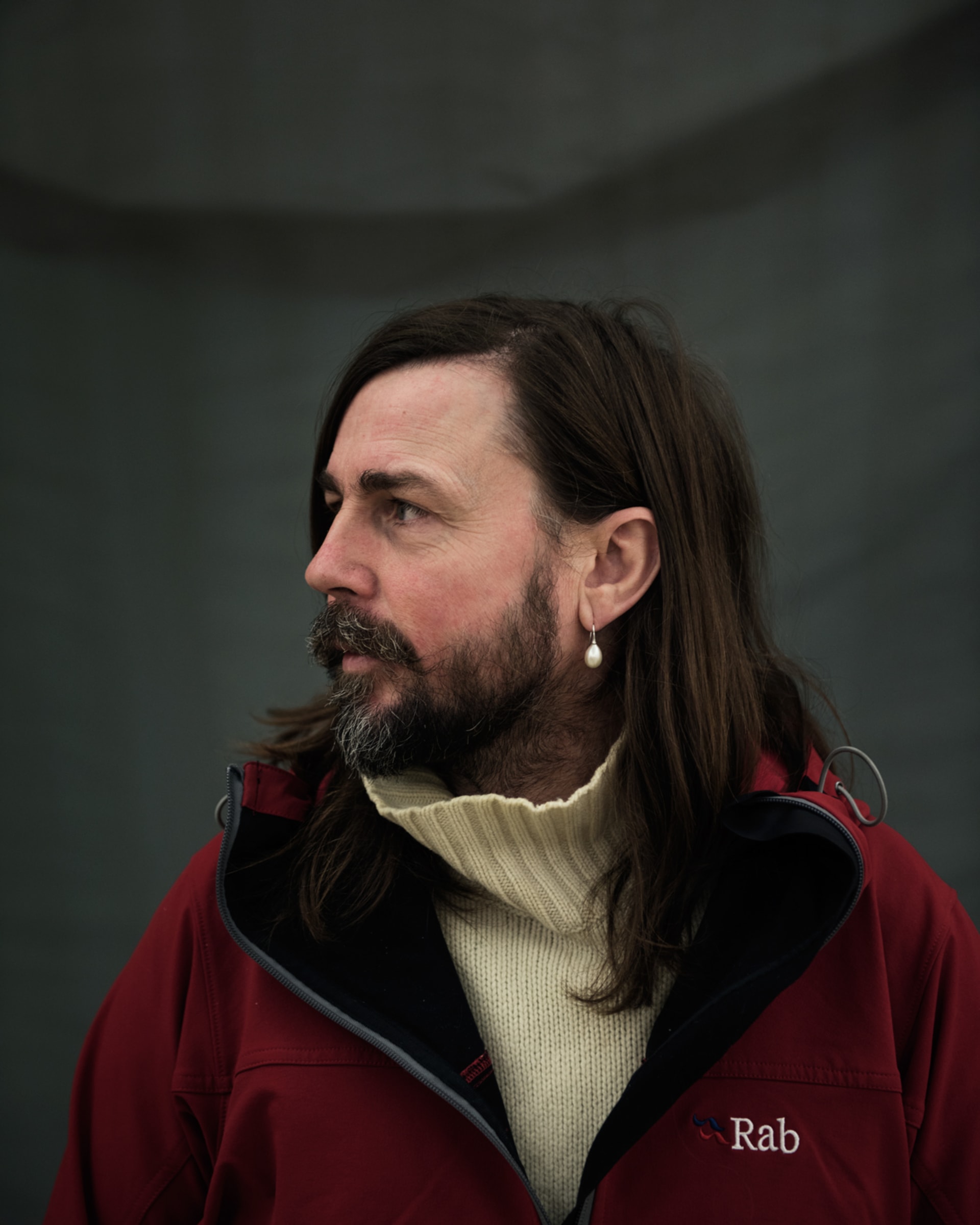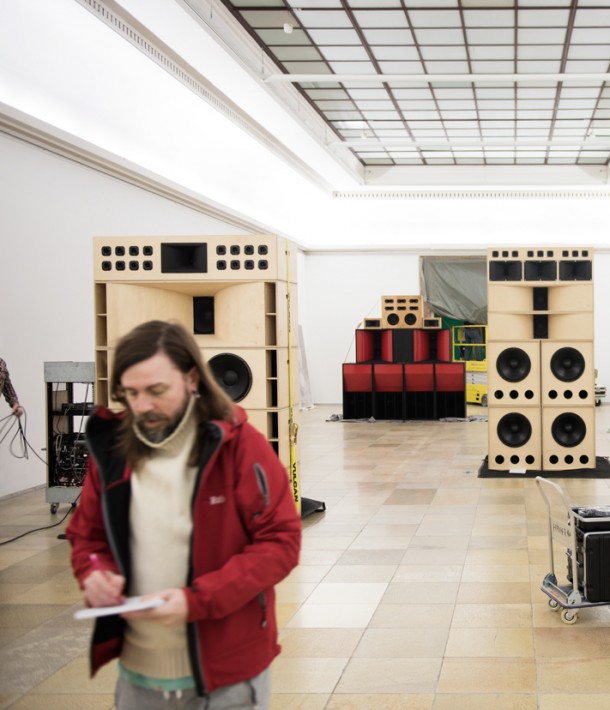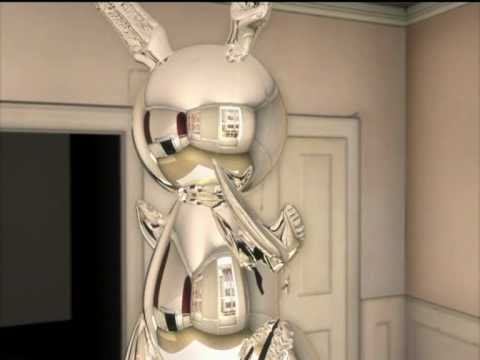
Here’s Why Mark Leckey is Dance Music’s Favorite Artist
With his 1999 video Fiorucci Made Me Hardcore, a hazy, slow-mo investigation of working-class British dance music culture sampled by Jamie xx on“All Under One Roof Raving,” Mark Leckey went from being an artist’s artist to being a musician’s artist as well. Since then, the 2008 Turner Prize winner has continued to champion the visceral power of music within the arcane discourses of visual art. It’s a position reinforced in his current German retrospective at Munich’s Haus der Kunst, where the lines between parody and pastiche blur together. As Max Dax found out, some sculpture just needs bass.
Mr. Leckey, you grew up in Liverpool where you started listening to music at a young age. For many, Liverpool is Beatles territory. What’s your first real music memory?
I listened to The Beatles when I was young, but Joy Division really left an impression on me when I was 15. There was this kids club at Eric’s Music Hall where groups like Joy Division would play an early show at 5 p.m. for us. I don’t think that there are still bands that would do that nowadays. I doubt it. And besides, the way that music is being produced has changed. Today’s music is being made on touch screens. Even the Roland TB-303 has become a plug-in, amongst others. I think music making has become much more playful than it used to be. And much more accessible. I tried to be in a band after I had seen Joy Division. I had to buy a bass guitar, I had to learn how to play and I had to practice. Nowadays you just buy a Native Instruments Maschine and you kick it off. If I had had a Maschine when I was 15 I’d have started making music and probably never have become an artist. I was just a lazy kid.
Being lazy as a kid is not a sin.
No, it isn’t. It isn’t a sin for an adult either. Making music just felt out of reach for me back then. It felt too complicated. I have a two-year-old daughter. Since she was one and a half she’s been allowed to play with an iPad app where you can create sounds, and she uses it intuitively. I like to believe that these machines—and it sort of started with Roland’s 303—are like cybernetic man-machines that are enchanted somehow.
If machines are enchanted, does that mean that the 303 has a soul?
I don’t know if it has a “soul.” But I believe in animism. I’d probably say that it has a djinni or a pixie in it. The 303 is enchanted in the sense that it takes control of you. It’s not necessarily an entirely positive relationship between man and machine. It has all these connotations to ideas like letting the music take control or your body being moved by the machine. It’s like the machine found a way to take over your physical body. At least that’s the way I feel about it. Yeah, it’s not a ghost but a djinni.
What’s the difference between a ghost and a djinni?
A djinni isn’t necessarily dead. You can summon it, like with a machine. A djinni is more magical than it is deathly. A djinni is not from the other side, but it is otherworldly. There are people who say that Kraftwerk are magicians because they work with enchanted machines.
Kraftwerk’s music prominently features in your video piece Fiorucci Made Me Hardcore.
When I was making Fiorucci, I remember that I was looking for music that was contemporary with whatever image that I was showing. I was a “casual” in the early ’80s. And even though casuals were not associated with music since they were not affiliated to a specific music group, I still remember that a lot of casuals were listening to either early Bruce Springsteen or Kraftwerk. Only a bit later everybody was into soul music, innit.
Soul as in Northern soul?
No, more like soul as in disco. But I remember when I first heard Kraftwerk I thought they were a novelty robot band. You know, like the band Space who had a huge electro-pop hit with their track “Magic Fly.” They wore astronaut’s suits in their videos. I thought Kraftwerk were of the same kind. Of course, I found out later that Kraftwerk really were the bridge. But as far as I’m concerned the music that is far more present in my work than Kraftwerk is “I Feel Love” by Donna Summer and Giorgio Moroder. That’s kind of the beginning for me. Kraftwerk were laying the alchemistic groundwork, and Moroder kicked everything into a whole new dimension.
The reason I ask about musical influences is that you recently stated in an interview that music is like a universal language that can be understood by everybody—whereas art seems to have an invisible barrier that keeps a lot of people away from being involved.
That’s still so true.
Your art shows a strong affinity towards music, as if you want to build a bigger bridge.
The Victorian literary critic Walter Pater famously said: “All art constantly aspires towards the condition of music.” That’s a lovely quote and I use it a lot because it encapsulates it, really. There’s something about music that’s ubiquitous. Actually, you could say the same about the Internet—it has that same ubiquity and pervasiveness. It basically just goes everywhere. And like you say, art seems much more restricted in that sense. It seems much more institutionalized, and there’s always a lot of context that surrounds it. It’s like you have to enter the ivory tower and to learn the language of art. But I personally think that this is changing. The distribution of images via the Internet has increased so much in the past few years, so I hope I’m right when I’m saying that the barriers are breaking down a bit.
It seems art is becoming more fashionable than ever before. It’s as if artists have become the new pop stars.
Art language kind of reaffirms the boundaries of what is art and what’s not. But if images—or in my case, videos—are being distributed online, then they enter the same field as images produced by people on YouTube and anywhere else. They become kind of flattened out as they all materialize on the same screen. Everything starts to commingle.
Let’s talk about your video work Pearl Vision from 2012. You once described it as a self-portrait. The video not only shows you playing a shiny, polished Pearl snare drum, but also, in a way, fetishizing it.
That’s obvious.
The camera zooms in on the shiny surface of the snare drum and you start to think that the image has been rendered because it’s just so perfect. It’s reminiscent of TV advertising—another universal language.
In fact, a part of the video is indeed rendered. This way, the object becomes more enchanted. It becomes more erotic, too. And let me tell you something: I am playing paradiddles on the snare, but the rhythm is eventually taking me. It is as if the snare is playing me. I’m possessed by the drum—it’s not me possessing it. In that sense, the paradiddle is like a spell or a chant to get this thing to come to life. It’s as if the drum hears you play the paradiddles and it kind of wakes up. And then the drum takes over.
Neil Tennant and the German painter Albert Oehlen both say that surface is the essence of pop.
Well, inch by inch I film or render the metal of the silver Pearl drum. Its surface reminded me of Jeff Koons’ silver bunny.
You seem to like Jeff Koons’ work a lot.
Absolutely. One of the reasons why I made Pearl Vision goes back to when I made my film Made in ’Eaven as an homage to Koons. I rendered his bunny and implanted it in a rendering of my then London flat. I then would “film” the bunny in my flat by getting closer and closer with the camera, catching the reflections of the flat. Koons works with a scale that goes beyond human measures. His work reminds me of my first visit to the Sistine Chapel. It’s a scale that’s beyond human comprehension. And that’s what Jeff Koons is doing. This kind of art seems like it appeared rather than it was made. That’s why its perfection mirrors capitalism. Suddenly, there is this perfectly made silver bunny. How the fuck did that thing get made? Of course you know it. But still, if you’re standing in front of the bunny, you remain speechless. You cannot compute what you just saw.
The computer can.
And that’s one of the reasons why I use the computer. I can render the bunny and suddenly it’s there. I have it. I own it. I could even print it out.
At a certain point the observer realizes that there’s no reflection of the camera in the bunny.
And that’s the connection to Pearl Vision: I made the bunny film so that I could look at it. But even more than that, I made it to have it. I could never afford to buy a real silver bunny from Jeff Koons. In that sense, both films are private. They’re fetish films. And with rendering, you can come even closer to the drum than in reality. The objects on screen seem to be more tangible than real objects. It’s a kind of exaggeration. And that’s exactly what I do—I amplify that confusion. Because I find it confusing to see something on a screen that I want to touch, feel the surface of and reach into.
Like in David Cronenberg’s Videodrome?
Exactly like Videodrome. Which relates back to animistic objects: That’s one of the great iconic modern animistic objects, that scene with the TV.
And at the same time you purposefully show logos of various brands in your videos. Your Pearl Vision video is obviously named after a brand and prominently features Sony headphones as well.In another video you have a Samsung refrigerator on display. Are you embracing these brands?
It’s less about embracing them. I don’t really have a choice. They’ve already taken my soul. I’m polluted by them. They are like material. There’s wood, there’s clay and there’s Samsung. Sony headphones have become a substance that an artist is allowed to use. Don’t forget that all the stuff I do is in response to the world. It’s not a critique; I just try to find out why things and substances fascinate me.

Do you identify with the brands you use in your imagery?
No. Samsung is a multi-national South Korean company that is mysterious and ominous and terrifies me. I mean, they also build military hi-tech stuff like aircrafts and bombs. When I use a stunning looking Samsung refrigerator in my video GreenScreenRefrigeratorAction I’m not celebrating the brand. All I’m doing is an amplification of the way I feel. I am just amplifying my feelings in a cybernetic way rather than in any expressionistic way.
Do you think that GreenScreenRefrigeratorAction might have made a great TV ad? I imagine that’s what Samsung would have thought.
Actually, there was this rumor that the Samsung piece was a kind of guerrilla TV spot. I first showed it at my show in the Serpentine Gallery in London. And apparently at the end of the show Samsung came in and did some kind of a photo call or whatever. They seemed like they wanted to use it somehow for an internal promo, as if their product had been blessed by my art. Obviously that’s very seductive for them. Someone told me when I was drunk, so I can’t really remember the details. But if you look at it in a satirical way, satire eventually becomes reality.
You never talked to Samsung?
No, never. I just bought that particular refrigerator, which at that time was the bachelor machine. And by that I mean it in the Duchamp way that it is a machine that doesn’t need any other input from the artist. But, I actually didn’t want to mention Duchamp.
Why? Your work to me seems to clearly follow his footsteps. He probably would have used video to film objects. Or bachelor machines.
I could clearly imagine him doing so, although I’d say that Duchamp was always very distant from what he was doing, like it was an intellectual game of art. But I find that really boring. I want art to do the same thing to me that music does to me. There’s a piece in my exhibition that’s called Big Box Statue. It’s a big, functioning sound system and it stands opposite to a big object—originally it was a big statue. When I go to a gallery and am confronted by any big object that I wish to have a response from, I find it very confusing. There’s a lot of noise of what I’m meant to think and the history of the object. Also, I want a genuine response to this thing. But I can’t get it. There’s too much noise in the way. So, instead of me just standing in front of this object, I treat the sculpture with sound. If you want to reduce the noise-to-signal ratio then you have to go sideways. You can’t go directly towards it.
So, in order to get a response from Duchamp’s urinal, you’d build up the sound system opposite to it and treat it with extremely low bass frequencies?
Exactly. The geological layers of “what it means” are sometimes just too heavy. You need subsonic bass and ultrasound to get through the core. I got interested in the idea of animism because of my experience with technology and how responsive it was to me. Technology almost seemed to predict my thoughts, to be telepathic.
Is that scary or fascinating?
It’s both. It’s that moment of cybernetic feedback where your input into the machine leads to an output from the machine. It’s what I wanted, but still it seems magical. It’s you and it. It’s kind of symbiotic. You can both be terrified by that and fascinated. The bachelor machine is a machine that makes you productive. And my productivity is all I care about. Nothing else matters for me.
This article originally appeared in the Spring 2015 issue of Electronic Beats Magazine with photos by Frank Bauer. To read more from this issue, click here.
Published May 19, 2015.



